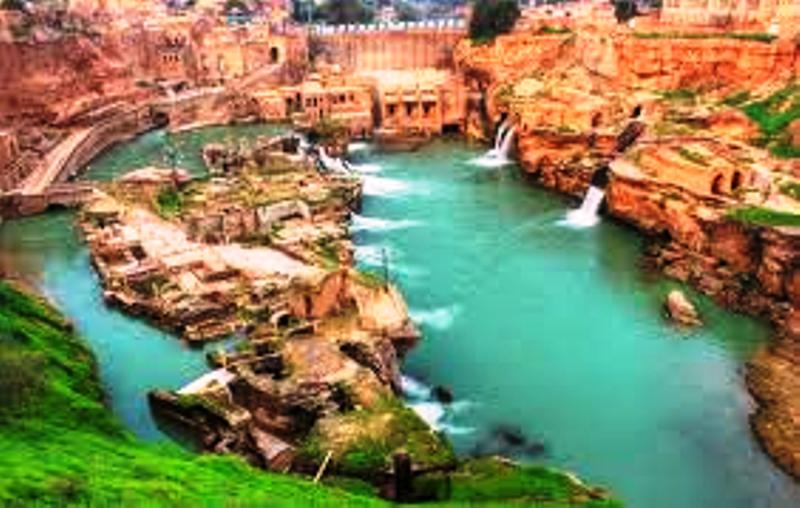
The waterfalls are planned and dug into the rocks on the new course of water chosen by the ancient engineers, iranontrip.ir wrote.
For more than 1,600 years, the mills inscribed as masterpieces of creative genius, can be traced back to Darius the Great in the 5th century BCE. It involved the creation of two main diversion canals on the Karun River of which the Gargar Canal is still in use providing water to the city of Shushtar via a series of tunnels that also supply water to mills.
It forms a spectacular cliff from which water cascades into a downstream basin. It then enters the plain located south of the city where it irrigates orchards and enables farming over an area of 40,000 hectares known as Mianab (Paradise). The property has an ensemble of remarkable sites including the Salasel Castel, the operation center of the entire hydraulic system, the tower where the water level is measured, dams, bridges, basins and mills. It bears witness to the know-how of the Elamites and Mesopotamians as well as more recent Nabatean expertise and Roman building influence.
Shushtar historical hydraulic system demonstrates outstanding universal value as in its present form which dates back to the 3rd century CE and probably on older bases from the 5th century CE.
It is complete, with numerous functions, and large-scale, making it exceptional.
Shushtar system is a homogeneous hydraulic system, designed globally and completed in the 3rd century CE. It is as rich in its diversity of civil engineering structures and its constructions as in the diversity of its uses (urban water supply, mills, irrigation, river transport and defense systems).
Shushtar Historical Hydraulic System testifies to the heritage and the synthesis of earlier Elamite and Mesopotamian knowhow; it was probably influenced by the Petra Dam and tunnel and by Roman civil engineering.
The Shushtar hydraulic system, in its ensemble and most particularly the Shâdorvân Grand Weir (bridge-dam), has been considered a wonder of the world not only by the Persians but also by the Arab-Muslims at the peak of their civilization.
The Gargar Canal is a veritable artificial watercourse which made possible the construction of a new town and the irrigation of a vast plain, at the time semi-desert. Shushtar historical hydraulic system sits in an urban and rural landscape specific to the expression of its value.
Criteria:
● (I): Shushtar hydraulic system is testimony to a remarkably accomplished and early overall vision of the possibilities afforded by diversion canals and large weir-dams for land development. It was designed and completed in the 3rd century CE for sustainable operation and is still in use today. It is a unique and exceptional ensemble in terms of its technical diversity and its completeness that testifies to human creative genius.
● (II): Shushtar historical hydraulic system is a synthesis of diverse techniques brought together to form a remarkably complete and large-scale ensemble. It has benefited from the ancient expertise of the Elamites and Mesopotamians in canal irrigation, and then that of the Nabateans; Roman technicians also influenced its construction.
Its many visitors marveled at it and receiving inspiration in turn. It testifies to the exchange of considerable influences in hydraulic engineering and its application throughout antiquity and the Islamic period under the various Iranian dynasties.
● (III): It is a unique and exceptionally complete example of hydraulic techniques developed during ancient times to aid the occupation of semi-desert lands.
By diverting a river flowing down the mountains, using large-scale civil engineering structures and the creation of canals, it made possible multiple uses for the water across a vast territory: Urban water supply, agricultural irrigation, fish farming, mills, transport, defense system, etc.
It testifies to a technical culture dating back eighteen centuries serving the sustainable development of a human society, in harmony with its natural and urban environment.
Integrity and authenticity
The integrity of the hydraulic footprint is good, but its functional integrity compared with the original model is only partial and reduced, notably for the dams; it remains good for irrigation and water supply. The authenticity of elements reduced to archeological remains is certain, but has been affected by 20th century works and materials so far as the civil structures and sites still in use are concerned. Efforts directed at restoring the attributes that demonstrate authenticity must be pursued.
Management and protection requirements
The components of the management plan are satisfactory, but they need to be improved in terms of analyzing the sites and encouraging the involvement of the local population.
Source: Iran Daily
9060**1771
Follow us on Twitter @IrnaEnglish
 solhkhabar | Peace International News Agency Peace International News Agency , Peace News , International Agency News of Peace
solhkhabar | Peace International News Agency Peace International News Agency , Peace News , International Agency News of Peace